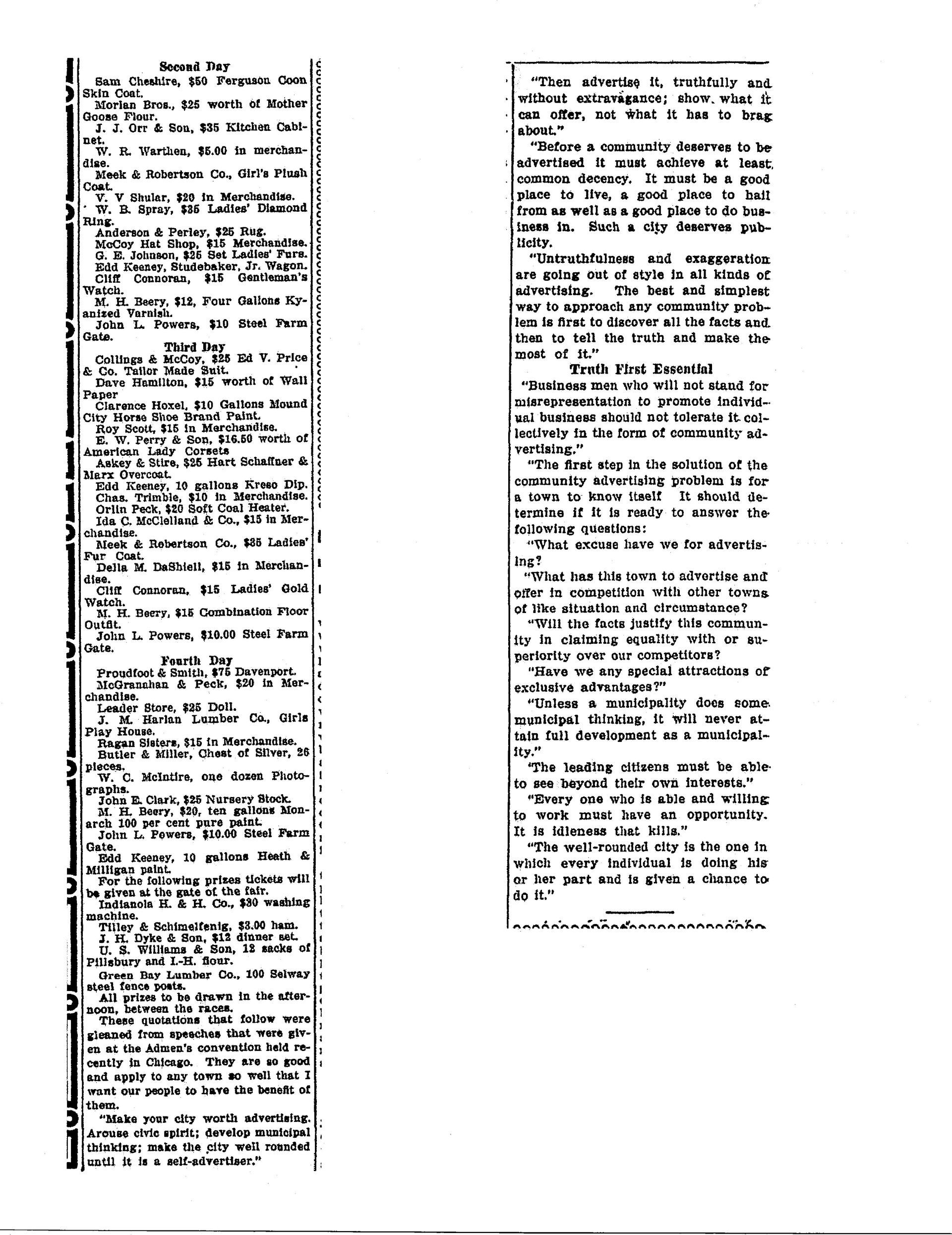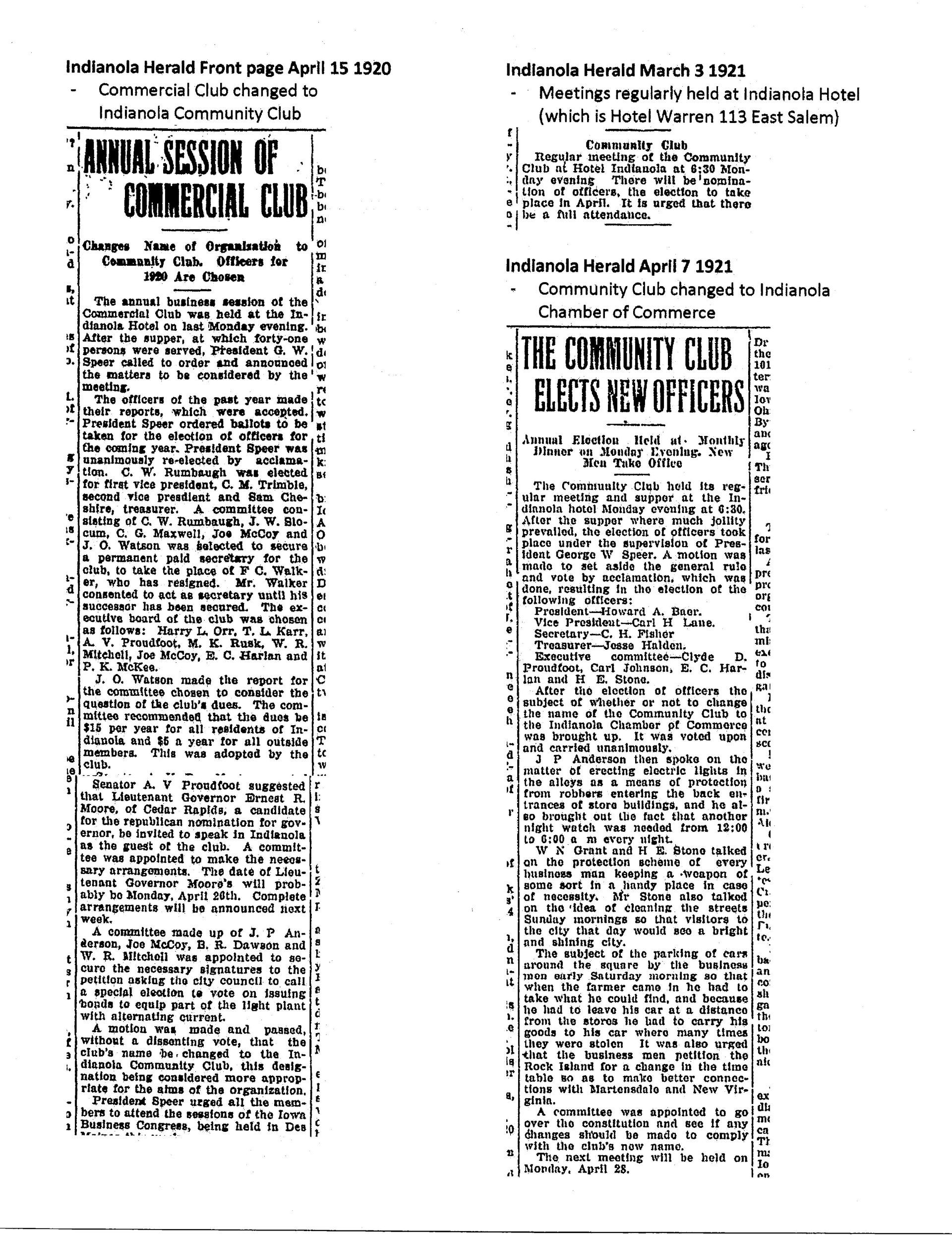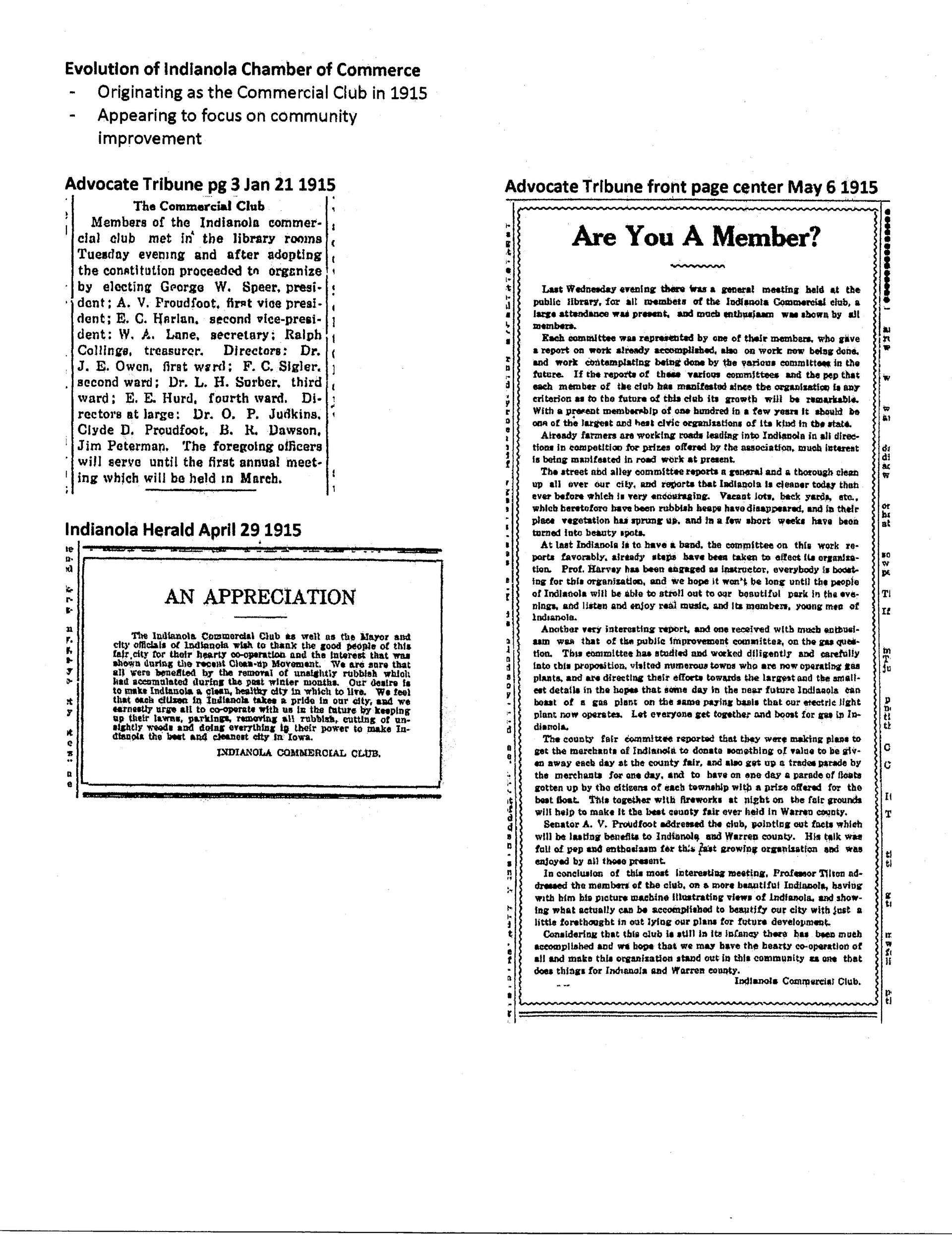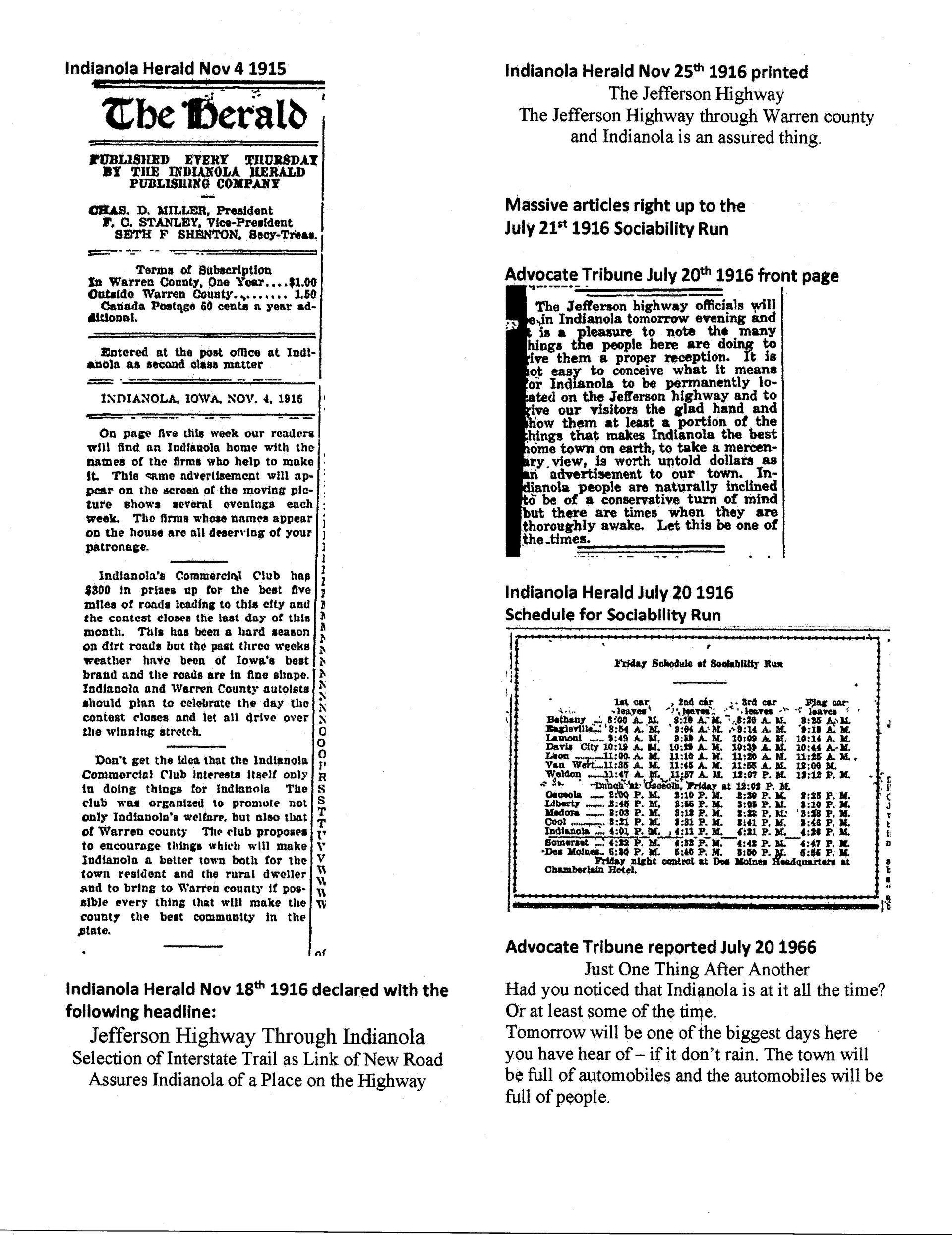History of Indianola
Indianola, A Thriving, Motivated, Caring and Collaborative Community
With easy access to Des Moines, Indianola maintains a small-town caring community spirit and is a great place to live, work, play and raise a family.
With top-flight K-12 schools, Simpson College, outstanding indoor/outdoor facilities, art, music, and appreciation for a rich past, Indianola has a thriving future.
1915 Newspaper | Chamber History
The Indianola Chamber of Commerce has a rich history, and one fascinating glimpse into the past comes from a newspaper published in 1915. The piece details the progress and prosperity of the town, highlighting its thriving agricultural industry and bustling downtown district. Reading this article from over a century ago, it's clear that Indianola has long been a community dedicated to growth and innovation.
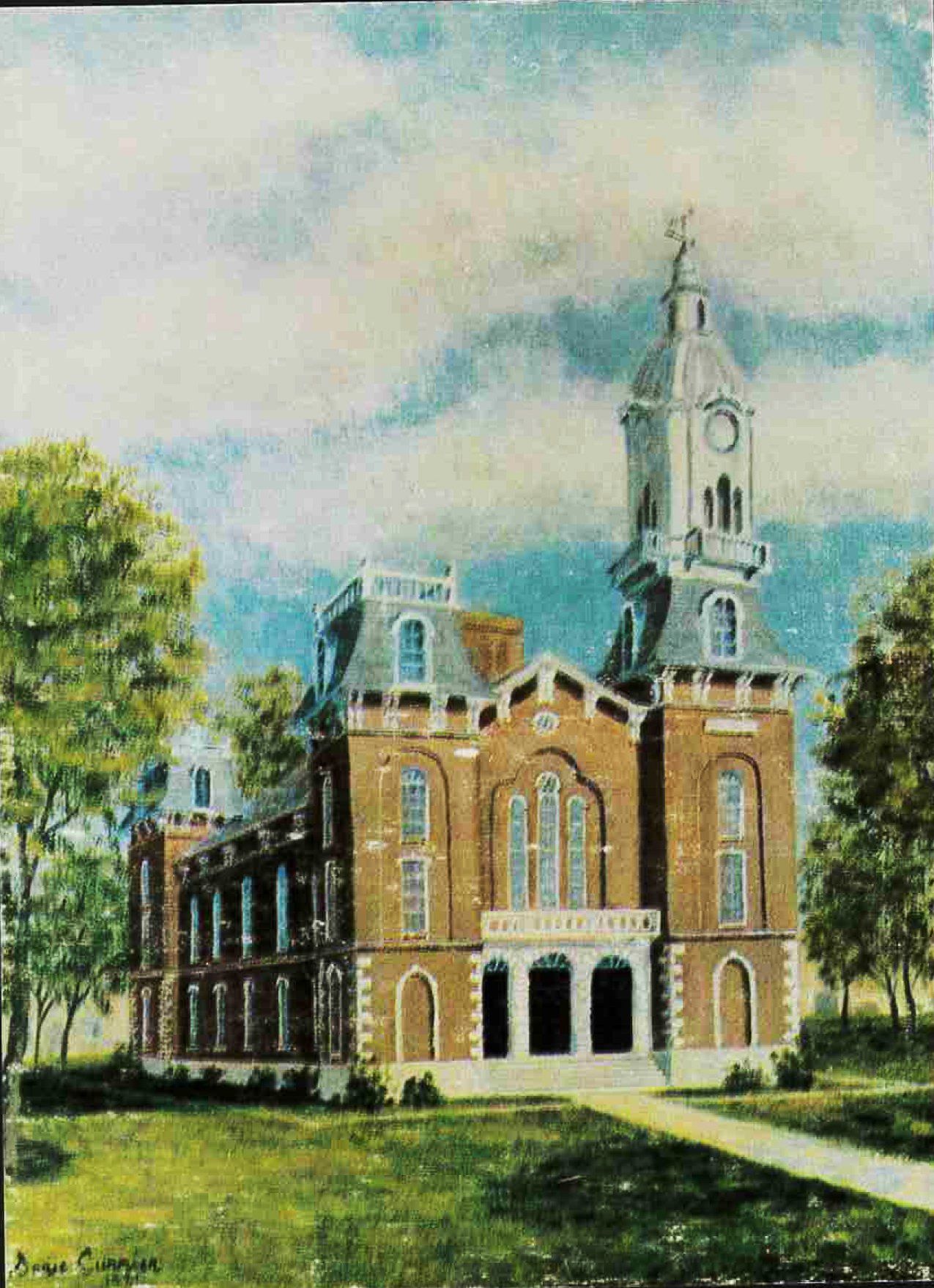
How We Came to Be
In 1846, Iowa’s 1st General Assembly established the boundaries of Warren County. Originally our northern border formed a continuous straight line across neighboring Marion and Madison counties like most Iowa counties, but that lasted only 4 days. A contingency of Polk County legislative representatives “borrowed” the upper portion of Warren County with quick passage of a supplemental bill. Adding land to southern Polk County made the city of Des Moines appear more centrally located inside their county lines. The ruse worked and Des Moines was chosen as Polk County’s seat of government instead of another community vying for the privilege. Warren County did not have an elected representative to protest the outrageous landmass loss until 1853. Even then, after heated discussion and compromise, Warren County lost land and a conforming appearance. Our northeast corner follows the contours of the Des Moines River and looks like a squiggly puzzle piece.
In April 1849 Colonel Paris P. Henderson, Sheriff of Warren County, was charged by Iowa’s First General Assembly to accompany representatives from Marion and Madison counties to find the place for a “seat of justice” in newly formed Warren County. The Colonel was carrying a sandwich wrapped in a piece of newspaper from the New York Sun (a penny 4-page tabloid), which included an article about Indianola, Texas. Mentioning the name to his companions, they put it to a vote and it was unanimously approved.
It was only 14 years later, in 1863, that Indianola was of sufficient size to incorporate, which allowed the city to form contracts, hold property, litigate and prosecute. Not everyone thought incorporation was a grand idea. Some argued it would increase taxes, disturb peace and quietude, and create difficulties between citizens. However, the petition was signed by 90 qualified voters and Indianola became a city.
A courthouse, or “seat of justice,” has always graced the center of Indianola’s square. In 1848, John Laverty, an early settler and trained surveyor, platted the 80-acres surrounding where the “seat of justice” would stand. Only a few log homes dotted the area but platting the land into lots selling for $5-20 constituted Indianola’s beginning.
The first courthouse was built in 1851 of hewn logs and served as more of a community center, schoolhouse, and place to learn news of the world from visitors. It was later sold and moved. The next courthouse was built of sandstone quarried three miles south of town and was completed in 186. The History of Warren County, 1879, stated, “The pride of the country is its courthouse. It is among the finest buildings in the state.” When the next new courthouse was dedicated on August 23, 1939, the men and women dressed in costumes from the 1860s, to honor their history. The women carried parasols and wore elaborate dresses, and the men dressed in top hats and tails like former President Abraham Lincoln. It is said 15,000 people attended the celebration. This structure was demolished in 1939 at the end of the Great Depression. A less stately brick and stone structure was erected on the same ground and over the next two years will be replaced by the new Warren County Law Enforcement Center and Courthouse.
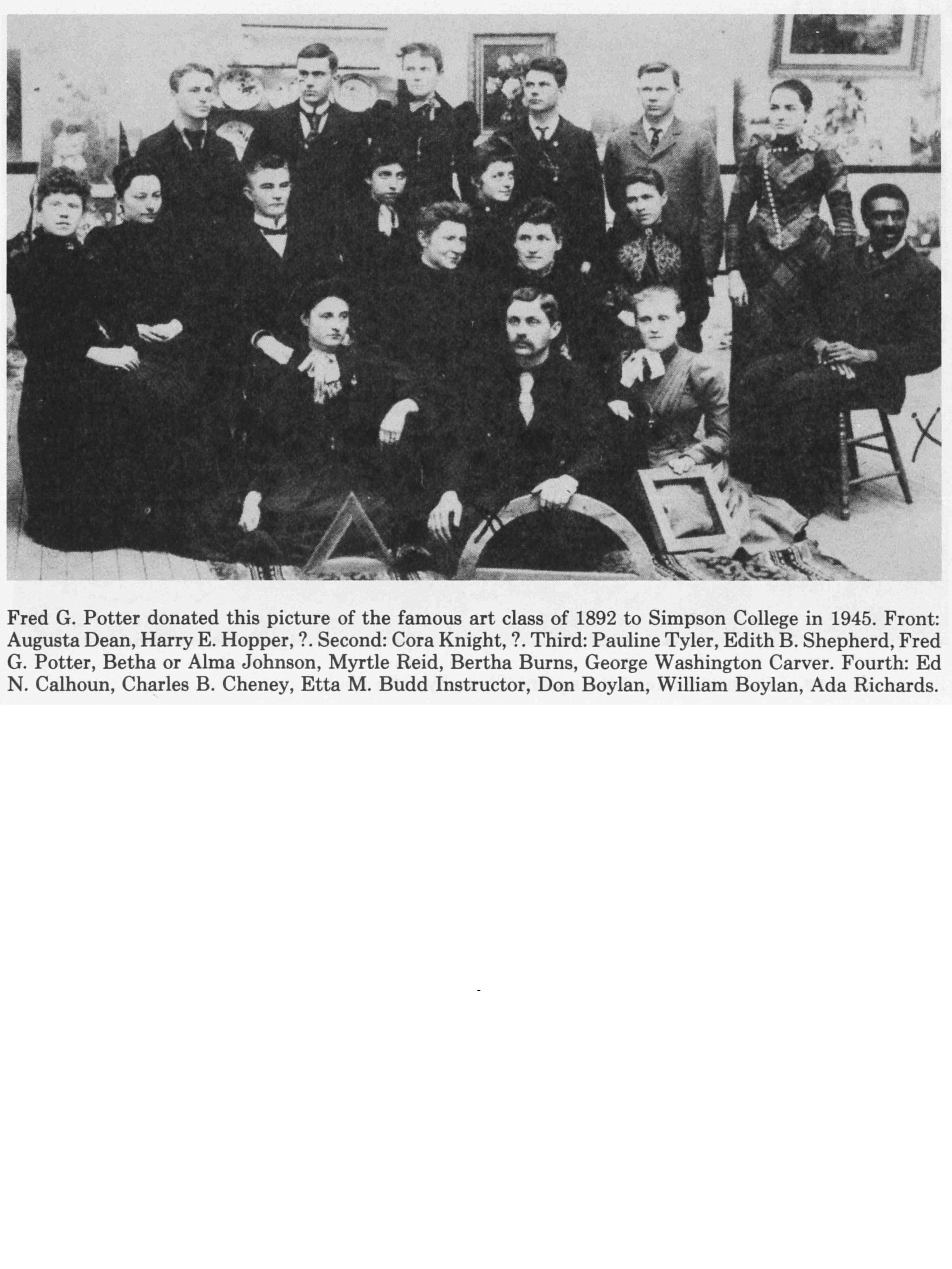
Making an Impact
Casey Blake
Aug. 23, 1973 – living today
Casey Blake is a former professional baseball player. He played from 1999 until 2011 in Major League Baseball (MLB) for the Toronto Blue Jays, Minnesota Twins, Baltimore Orioles, Cleveland Indians, and Los Angeles Dodgers. Casey and his wife, Abbie, generously donated towards the construction of the Blake Fieldhouse and the creation of the Indianola Community Youth Foundation (ICYF) that helps provide opportunities for kids to develop their personal best, make good choices, model positive behaviors, and build leadership skills.
Christopher M. Street
Feb 2, 1972 – Jan 19, 1993
Chris Street was an outstanding basketball player who played power forward for the Iowa Hawkeyes. Chris was a protentional NBA player, but was killed in an automobile accident in January 1993. Following Chris’ death, Tom Davis, Iowa Head Basketball Coach, said, “Chris represented all that is good about the Midwest and the state of Iowa.” Chris still holds the University of Iowa record for consecutive free throws. Chris’s number (40) was retired by the Hawkeyes on February 6, 1993 and an annual award was created in 1993 to honor Chris’ spirit, enthusiasm, and intensity. The Chris Street Memorial Gymnasium, located at the Indianola Middle School, and the annual Chris Street memorial basketball tournament also honor Chris’ legacy.
Lane Sisters
1903-1992
The Lane Sisters (Leota, Lola, Rosemary, and Pricilla) were a famous family of American singers. The remaining sister, Martha, did not follow the others in show business. They grew-up in Indianola where their father had a dental practice and owned a large home with rooms rented to Simpson College students. The Lane Sisters achieved success during the 1930s as a singing act, with their popularity leading them to the Hollywood film industry.
Private Russell Marshall
1896-1918
Warren County’s first casualty of World War I (The War to End All Wars) was 22-years-old Private Marshall. He was advancing, rifle in hand, in the town of Badonvillier, France, when killed by a hand grenade. He is honored in the Gold Star area at Indianola IOOF Cemetery (0.7 mile south of town in Hwy 65/69).
Clarence Luther Pickard
May 28, 1890 – Dec 22 1982
The first bicycle race across Iowa began August 26, 1973, in Sioux City, and ended August 31, in Davenport. The ride was informally referred to as "The Great Six-Day Bicycle Ride.” Almost 300 cyclists started the ride and only 114 finished the route. Among them was 83-year-old Clarence Pickard of Indianola. He rode a used ladies Schwinn wearing a long-sleeved shirt, trousers, woolen long underwear, and a silver pith helmet. Well-known, easily recognized, and beloved by remaining old-timers, Pickard’s bike, pictures, and other memorabilia will be on display during RAGBRAI.
Don L Berry
Oct 8, 1880 – Nov 1974
Don Berry was born Oct. 8, 1880, in Indianola and home schooled until starting Simpson College in 1899. After graduation, he went to work as a journalist for the Des Moines Register. Berry raised draft horses and helped market timber in the Pacific Northwest for Harry Hopper, Indianola first millionaire. In 1920 Don Berry purchased what became The Record-Herald and Indianola Tribune, and remained editor and publisher for 40 years. These were the glory days for the printed daily news.
Berry’s passion for photography captured rural life through a unique lens for decades. Many Indianola homes treasure a framed copy of “Cadence on the Plow,” a stunning 1938 photo of four draft horses pulling a wagon during harvest with front legs in perfect step. Don Berry co-authored a history of Warren County with Gerald Schultz when he was 73 years. He died at 94 years, never losing passion and enthusiasm for Indianola and Warren County.
Catherine “Kate” Shelley
Dec 12, 1863 – June 21, 1912
17-year-old Kate helped support her mother and siblings in Boone County, Iowa, by plowing, planting, and hunting after her father died of consumption (tuberculosis). It was after a violent rainstorm in July 1881, which caused a flash flood on nearby Honey Creek to damage the railroad’s trestle bridge that tested her mettle. At 11pm that night, Kate, and her family heard the crash of a train wreck near their home. Knowing the midnight train to Omaha was coming and would collide with the wreckage, Kate crawled across the damaged trestle bridge with a raging river below and lightning flashes illuminating her way. Once across, she ran a mile to the depot for the crew to sound a warning. Kate received many gifts for her bravery, among them tuition to Simpson College, which she attended for a year. In 1901, the Kate Shelley High Trestle Bridge (Boone, Iowa) was completed in honor of her heroism.
Jane Brown Moore
March 16, 1807– Feb 27, 1886
The great-great-grandmother of President Richard M. Nixon, and one of Iowa’s pioneer women, is buried in the old City Cemetery south of Indianola. The Daughters of the American Revolution (DAR) have placed a marker at the grave.
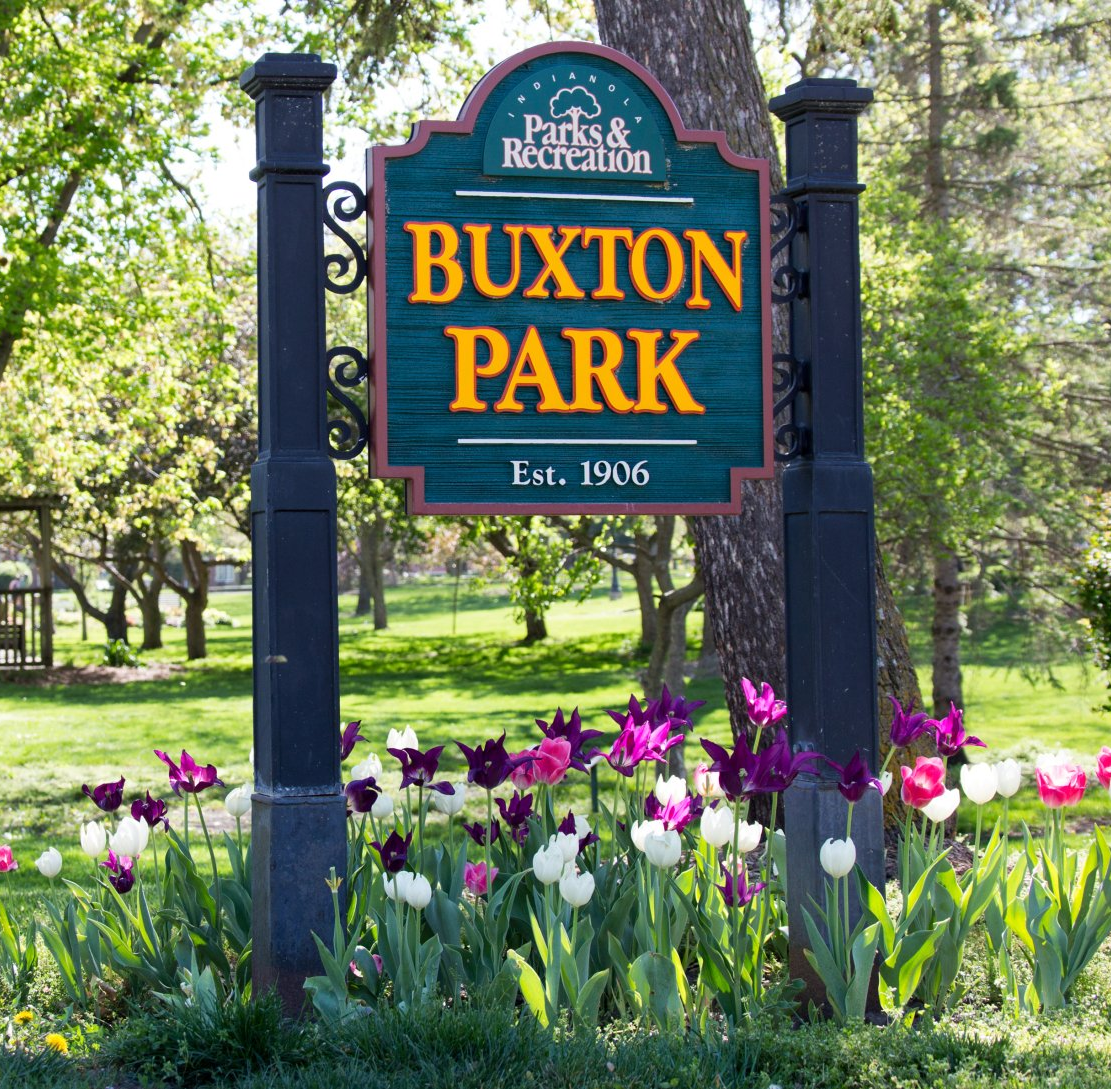
A Small-town with a Rich History
George Washington Carver Museum: The Warren County Historical Museum and Research Library (1400 West 2nd Ave) houses the cabin where Carver lived while attending Simpson College. He studied art and piano and the museum displays works of flowers and plants that he did while at Simpson. A multitude of displays surround the weathered structure describing this great man’s life (1864-1943). Carver was an American agricultural scientist and known for helping southern states find uses for alternative crops like the peanut and sweet potato. Born into slavery, he said, “At Simpson the kind of people there made me believe that I was a human being.”
National Balloon Museum: At the north entrance of town, (1601 North Jefferson Way) the museum is home to the US Ballooning Hall of Fame, which provides a comprehensive understanding of ballooning by archiving more than 200 years of flight history including winners of the US National Hot Air Balloon Championship and the National Balloon Classic. Indianola has hosted a competition balloon event since 1970.
Warren County Fair: In 1845, Iowa was the 29th state to be admitted into the Union. Ten years later, the first Warren County Fair was held October 1-2, 1855 in the southeast part of Indianola. The following year, the fair was held on 20 acres of ground that was purchased by the Warren County Agricultural Society for $320. The fairgrounds look much different today, but it is still held at this same location. Today the fair combines youth and open class exhibits with delicious fair food, carnival rides, music and grandstand events for an annual event that is“kind of a big deal!”
Warren County Historical Society Museum and Research Library: Located along the east side of the county fairgrounds, the museum holds several displays as well as a working model railroad of Indianola in the 1950s. On museum grounds sits Heritage Village, a grouping of authentic structures, and the George Washington Carver Museum. The museum will be open special hours during RAGBRAI, with genealogical experts, local historians, and model railroaders available. Warren County Log Cabin Days are held here each September.
Carnegie Library: Indianola built a library a block from The Square (106 West Boston Ave) after receiving $10,000 in funding from Andrew Carnegie in 1903. Andrew Carnegie was the richest man in American at the time and funded 108 libraries across Iowa and 1,689 public libraries nationwide. The Des Moines Metro Opera (DMMO) made the library their headquarters in 1984 and placed the building on the National Registry of Historic Places. A glass atrium and full remodel has just been completed.
Jefferson Highway: Indianola is among a few places to remember the first transcontinental highway in the United States. The Jefferson Highway started in the pines of Winnipeg, ended in the palms of New Orleans, covered 2,300 miles, and followed Hwy 65/69 (north-south) through Indianola. The highway’s route was established in 1915 and every town chosen along its way had to maintain a smooth hard-packed road. “The Mud Must Go,” was the battle cry for this new “Auto Trail” to promote tourism and travel. Indianola still uses “Jefferson Way” in addresses along Hwy 65/69 in remembrance of this grand undertaking.
Buxton Park: Buxton Park Arboretum is an arboretum and botanical garden located at the intersection of North Buxton Street and West Girard Avenue, Indianola, Iowa. It is open to the public without charge. The 5.4 acres Arboretum was donated to the town in 1906 by William and Francis Buxton.
Lake Ahquabi State Park and Banner Lakes at Summerset State Park: Indianola is located between two beautiful state parks which provide year-round outdoor recreation opportunities. Lake Ahquabi offers a spacious campground, boat rentals, fishing, sandy beach & trails featured in a 770-acre preserve. Banner Lakes at Summerset State Park is Iowa’s newest state park and features a 2-mile bike trail loop, boating, fishing, and has a nearby-shooting range and pubic hunting.
Summerset Trail: Explore Summerset Trail on bike or foot. The trail is 11.1 miles long, follows the route of an abandoned rail line and passes through prairie, wetlands, woodlands and along the Middle River southwest of Carlisle. It connects with the Carlisle Nature Trail on the northeastern end and McVay Bike Trail at the southwest. The Jerry Kelly Trail can also be accessed from the Summerset Trail.
Corner Sundry: For 70 years people have grabbed a straw and slurped an old-fashion phosphate, cherry coke or other fountain drink at this popular spot. The Harlem Globetrotters, and national political candidates have also twirled a seat at the counter.
Crouse Café: This long-time family restaurant serves homemade pie. Their cherry pie topped with ice cream appeared in a Des Moines Register article as one of the top 100 Things to do Before You Die!
Downtown Indianola: Watch for plaques recording the history of various buildings on the Indianola Square.
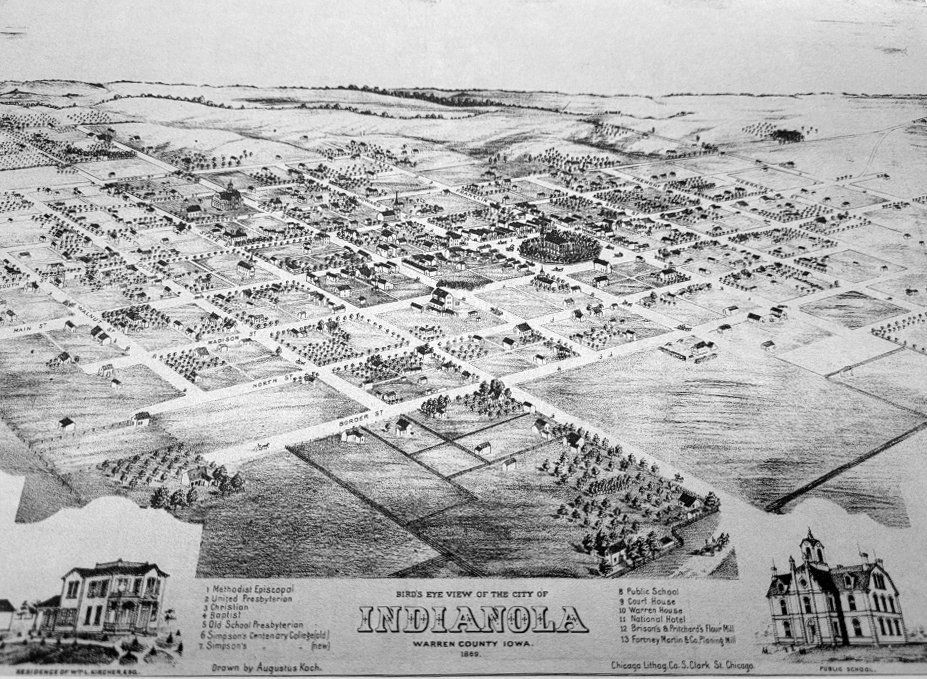
Warren County’s only hanging may have been a botched job…
Reuben Proctor was accused of murdering 16-year-old Augusta Cading after entering her home in a robbery attempt on Halloween night 1877. Augusta’s father and brother were in Indianola and her mother was a bedbound invalid. Despite being shot in the chest and hand, Augusta pushed the intruders outside before succumbing to her injuries. Reuben was arrested in Des Moines and brought to the Indianola jail (where the Post Office is now). Almost two weeks later, a vigilante group of 100 men attempted to burn the jail with Reuben inside. Thwarted by the locked iron-clad door and 2-inch plank walls, they left on horseback firing their guns into the air.
Court proceedings started near Milo with a visit to the Cading farm. Augusta’s testimony took time, she was failing. Returning to Milo, the sheriff and deputy were walking Reuben to court after dinner when a mob of men pushed the lawmen aside, grabbed Reuben, threw a noose around his neck, and hung him from the stockyard scale. No one was arrested, the sheriff declared Reuben dead, and gave the body to his family. Augusta died a few days later.
It is truth or rumor, but while family members held vigil over Reuben’s body, his face never turned waxy and his extremities never chilled. He was revived with vigorous rubbing, and remembering his near demise, Reuben Proctor ran away, never to return, leaving behind a young wife and two small children.
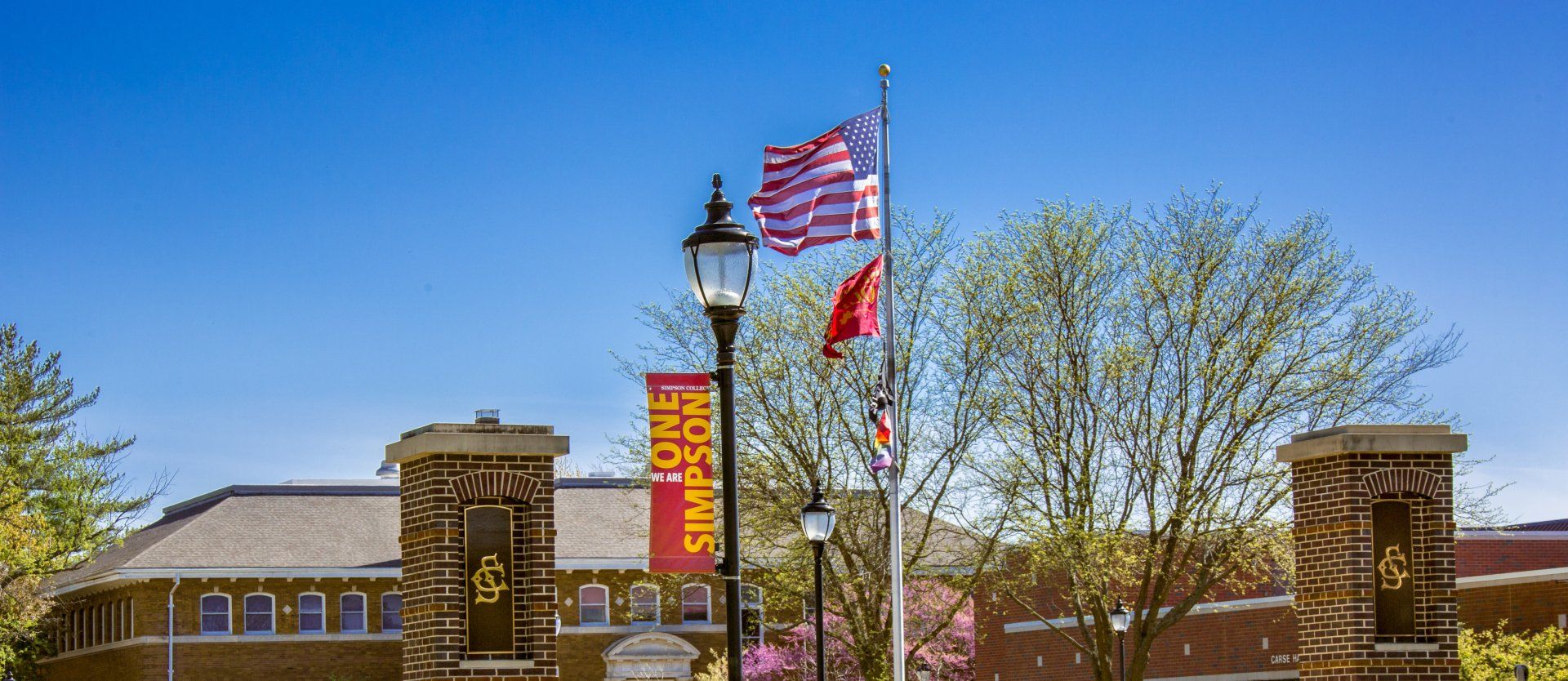
A Campus in the Making
In 1860, a handful of Indianola citizens launched an enterprise, which became Simpson College. Their goal was to establish an institution of higher education beyond common school, or ungraded elementary school. Strolling the grounds today, the buildings on campus span 150 years of change, style, and success:
1870 College Hall (formerly Old Chapel): Oldest remaining building on campus and said to have the ghost of freshman Mildred Hedges, who fell to her death from the third floor, tripping and falling with an armful of books.
1889 Wallace Hall (formerly Science Hall): Built in a Romanesque Revival style and listed on the National Registry of Historic Places, once had an attic classroom where George Washington Carver studied art.
1921 Hillman Hall (formerly Central Building): Designed by Proudfoot & Bird, a prominent Des Moines architectural firm.
1912 Hopper Gymnasium: A state-of-the-art facility funded by Harry Hopper, Indianola’s first millionaire.
1949-1963 Brick-building frenzy: Pfieffer Hall, Carver Hall of Science (north half), Barker Hall for men, and Kresge Hall for women.
1964 Dunn Library: Designed by Richard Neutra, with bricks laid upright to represent higher learning; many said it could not be done, but the building’s integrity proves otherwise.
1967 Buxton Hall (formerly Franklin Hall): Built for men and women to live together, initially in separate wings, but not anymore.
1968 Smith Chapel: Design and function causing considerable consternation before a stone was laid; today the location of events and weddings with a friendly coffee shop.
1971 Blank Center of Performing Arts: Housing the Theatre Arts department during the school year and the Des Moines Metro Opera during summers.
1983 Amy Robertson Music Center: Funded by a fiercely independent woman with an early pioneer spirit, she was a dedicated and uncompromising patron of Simpson College until her death at 94 years.
2012 Kent Campus Center: Center of campus life and many community events, bringing town and gown together. The Simpson Experience Walkway, between Kent Center and the athletic complex, provides a glimpse of Simpson’s past, present and future in photos and memorabilia.

